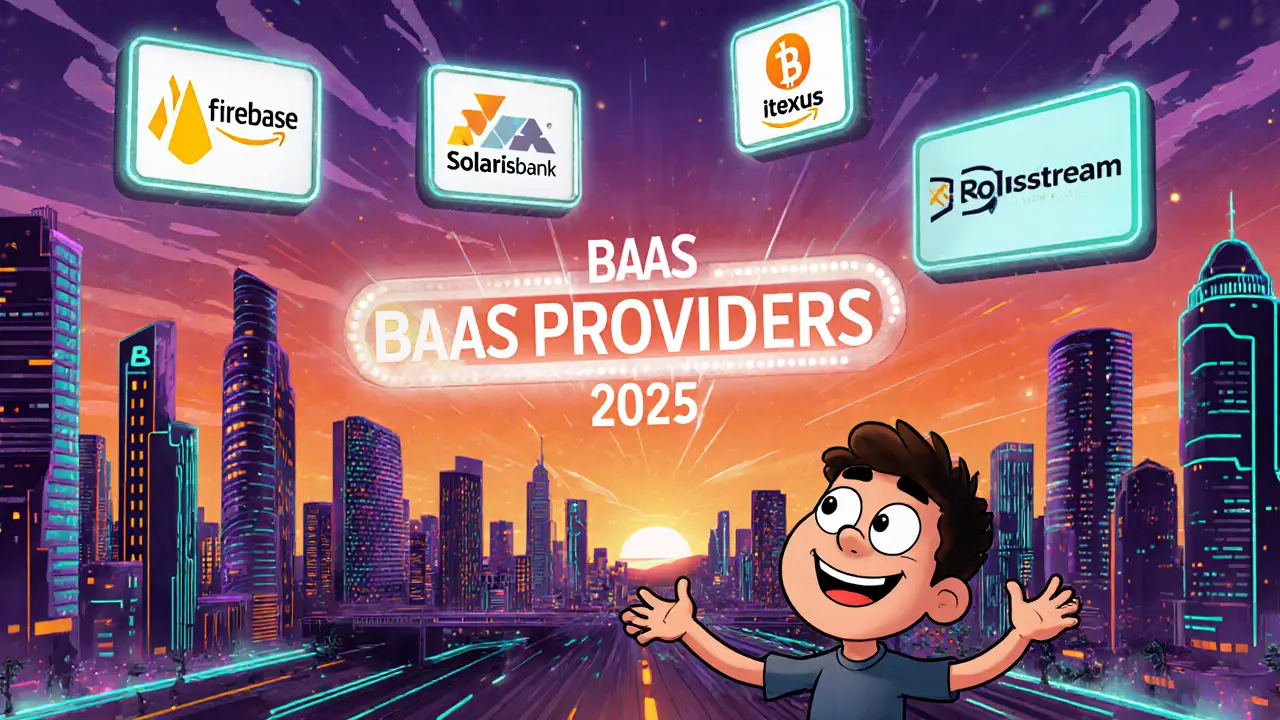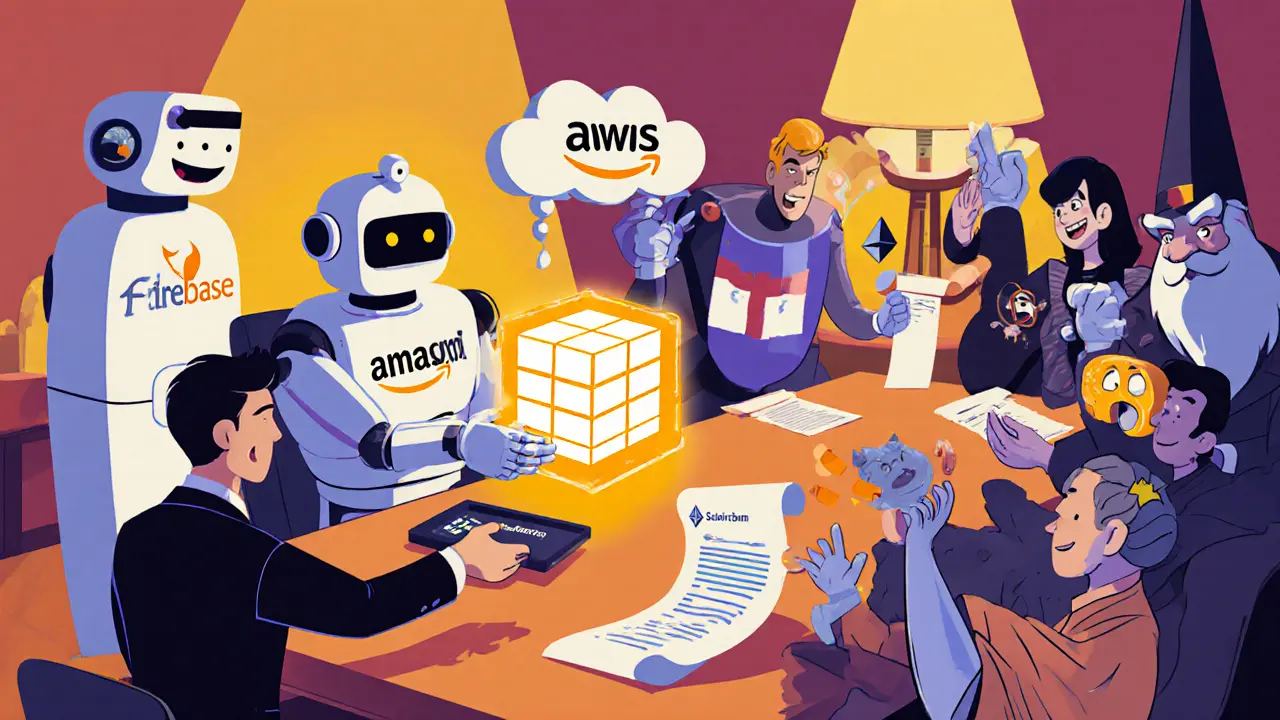Top BaaS Providers to Watch in 2025 - Backend, Banking & Blockchain

Jul, 26 2025
When you hear BaaS providers 2025 is a collective term for Backend as a Service, Banking as a Service, and Blockchain as a Service platforms that supply ready‑made cloud infrastructure to developers and enterprises, the first question is: which ones actually deliver what you need?
Why BaaS matters in 2025
Three trends converge to make BaaS essential today. First, the pace of digital product launches has exploded - teams can’t afford to build servers from scratch. Second, regulatory pressure, especially around payments and data privacy, pushes firms toward providers with built‑in compliance. Third, blockchain and AI workloads demand specialized infrastructure that traditional cloud vendors don’t always expose. In short, picking the right BaaS partner can shave months off development, lower operational risk, and keep you on the right side of regulators.
Backend as a Service (BaaS) - Core Players
Backend as a Service focuses on the classic app stack: auth, databases, file storage, and real‑time sync.
- Firebase is Google’s all‑in‑one platform offering a real‑time NoSQL database, authentication, hosting, and analytics. The freemium model lets startups start for free, while the Blaze pay‑as‑you‑go plan scales to enterprise traffic.
- AWS Amplify bundles Amazon Cognito, GraphQL/REST APIs, storage, and CI/CD pipelines. Pay‑per‑use pricing mirrors the wider AWS ecosystem, making it a natural fit for teams already on the Amazon stack.
- Back4App provides managed Parse Server hosting, real‑time queries, and an easy drag‑and‑drop dashboard. It’s popular with developers who love the original Parse API but need a fully managed service.
- Supabase markets itself as the open‑source Firebase alternative. It runs on PostgreSQL, offers instant REST and real‑time GraphQL endpoints, and keeps pricing transparent - $0 for hobby projects, $25/mo for the first 8 GB of storage.
- Appwrite delivers self‑hosted and cloud backends with support for multiple languages, WebSocket‑based real‑time, and a built‑in user management system.
When evaluating these services, look at data residency options, real‑time performance (WebSocket vs. polling), and how they integrate with your front‑end framework (React, Flutter, etc.).
Banking as a Service (BaaS) - Who Leads the Pack?
Banking as a Service lets non‑banks embed accounts, cards, payments, and compliance into their products through APIs. The landscape is still Europe‑centric, but a few global players are expanding fast.
- Itexus offers a fully customisable stack: core banking, KYC, payment gateways, and a sandbox for rapid prototyping. Its API‑first design makes it popular with fintech startups looking for a white‑label solution.
- Solarisbank holds a full German banking licence, providing accounts, debit cards, and lending APIs across the EU. Its modular pricing lets you pay only for the features you consume.
- Bankable focuses on modular payment rails - from card issuance to instant settlement - and markets heavily toward high‑volume merchants.
- ClearBank, the UK’s first cloud‑native clearing bank, supplies real‑time settlement and API‑driven onboarding for neobanks and non‑bank fintechs.
- Treezor, backed by Société Générale, combines API‑driven payments, e‑wallets, and SEPA processing under a single EMI licence covering 25 European countries.
Key decision points include licence coverage (EU passport vs. local licence), settlement speed (instant vs. next‑day), and the depth of compliance tooling (KYC, AML, GDPR).

Blockchain as a Service (BaaS) - The Heavy Hitters
Blockchain as a Service abstracts node management, consensus configuration, and smart‑contract deployment. It’s a fast‑growing niche as enterprises experiment with supply‑chain, tokenisation, and decentralized finance.
- Rapid Innovation stands out for its hourly‑rate pricing and a 90‑day deployment guarantee. It supports Ethereum, Hyperledger, and custom sidechains, making it a go‑to for quick PoC builds.
- Blockstream focuses on Bitcoin infrastructure - satellite‑based block propagation, Liquid sidechain, and Lightning‑Network APIs for high‑throughput settlement.
- Kaleido provides a multi‑protocol business cloud, letting you spin up Ethereum, Quorum, or Corda clusters with a single UI and integrated identity management.
- Bloq offers enterprise‑grade tooling for large‑scale blockchain deployments, including governance dashboards and automated upgrade pipelines.
- tZERO delivers regulated token‑trading platforms and custody services, targeting institutional investors entering the digital‑asset space.
When choosing a blockchain BaaS, ask about consensus options (PoW vs. PoS), data‑privacy guarantees (private vs. public nodes), and integration with existing cloud providers.
Side‑by‑Side Comparison of Leading Providers
| Provider | Category | Core Services | Pricing Model | Notable Clients |
|---|---|---|---|---|
| Firebase | Backend | Realtime DB, Auth, Hosting, Analytics | Freemium → Pay‑as‑you‑go | Lyft, Alibaba |
| AWS Amplify | Backend | Cognito, GraphQL, Storage, CI/CD | Pay‑per‑use | Airbnb, Netflix |
| Itexus | Banking | Accounts, Cards, KYC, Payments | Custom‑based on volume | Revolut‑type startups |
| Solarisbank | d>Banking | Bank accounts, Debit cards, Lending API | Modular, per‑feature | N26, Penta |
| Rapid Innovation | Blockchain | Ethereum, Hyperledger, Smart‑contract tooling | Hourly + 90‑day guarantee | Supply‑chain pilots |
| Blockstream | Blockchain | Bitcoin nodes, Liquid sidechain, Satellite API | Subscription tier | Ledger, Crypto exchanges |
How to Choose the Right Provider for Your Project
Follow this quick checklist. Tick each box before you sign a contract:
- Scalability: Can the service handle spikes of 10× traffic without manual re‑architecture?
- Security & Compliance: Look for ISO‑27001, SOC 2, and region‑specific licences (e.g., EU EMI for banking).
- Integration Ecosystem: Does the provider offer SDKs for your stack (React Native, Flutter, Unity for gaming, etc.)?
- Cost Predictability: Compare pay‑as‑you‑go vs. flat‑rate plans; factor in hidden costs like egress or compliance fees.
- Support SLA: 24/7 live support is a must for production finance apps.
- Innovation Roadmap: Providers that are adding AI‑driven analytics or Web3 modules will keep you future‑proof.
By scoring each provider on a 1‑5 scale across these dimensions, you can quickly spot the best fit.
Current Trends Shaping BaaS in 2025
Two forces dominate the market:
- Embedded Finance: More non‑financial brands (e‑commerce, SaaS, rideshare) are adding banking APIs to boost stickiness. This pushes BaaS firms to bundle payments, credit, and insurance in a single SDK.
- AI‑Powered Infrastructure: Providers are integrating Large Language Model (LLM) assistants for dev‑ops (auto‑scaling, security alerts) and offering AI‑enhanced fraud detection for banking APIs.
European regulators continue to favour EMI‑licensed platforms, giving providers like Solarisbank and Treezor a cross‑border edge. Meanwhile, the blockchain space is seeing a burst of “service‑level‑guarantee” contracts - 90‑day deployment windows are now a competitive baseline, thanks to Rapid Innovation’s success story.
Key Takeaways
- Backend platforms (Firebase, AWS Amplify) dominate mobile/web app backends, while open‑source alternatives (Supabase, Appwrite) gain traction for cost‑sensitive projects.
- Banking‑as‑a‑Service leaders (Itexus, Solarisbank) offer full‑license coverage across Europe, making them ideal for cross‑border fintechs.
- Blockchain‑as‑a‑Service is maturing; providers now bundle deployment guarantees and AI‑driven analytics (Rapid Innovation, Blockstream).
- Focus on scalability, compliance, integration, predictable pricing, support, and roadmap when picking a partner.
- Embedded finance and AI‑enhanced services are the growth engines to watch through 2026.
Frequently Asked Questions
What is the difference between Backend, Banking, and Blockchain as a Service?
Backend as a Service supplies generic cloud back‑end features (auth, DB, storage). Banking as a Service adds regulated financial APIs (accounts, cards, KYC). Blockchain as a Service provides managed blockchain node hosting, smart‑contract tools, and ledger‑specific services.
Can I use a single provider for all three BaaS categories?
A few major cloud players (AWS, Google Cloud) offer modules across the three categories, but most businesses pick specialised partners for banking and blockchain to meet compliance and performance needs.
How do I evaluate pricing for BaaS providers?
Start with a usage forecast (monthly active users, transactions, storage). Compare pay‑as‑you‑go rates versus flat‑rate bundles, and watch for extra fees like egress, compliance checks, or premium support.
Which BaaS provider is best for a gaming startup?
PlayFab (Microsoft) is purpose‑built for game back‑ends - it offers player profiles, leaderboards, and real‑time matchmaking. If you prefer an open‑source stack, Supabase combined with a dedicated game server works well too.
Do European BaaS providers support non‑EU markets?
Yes. Providers with an EMI licence (Solarisbank, Treezor) can passport services across EEA countries and many have agreements to extend into the US, UK, and APAC via partner banks.